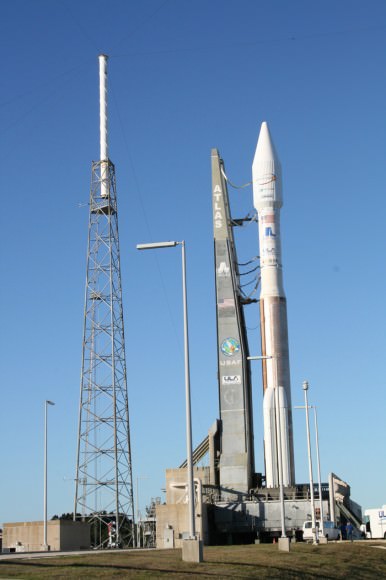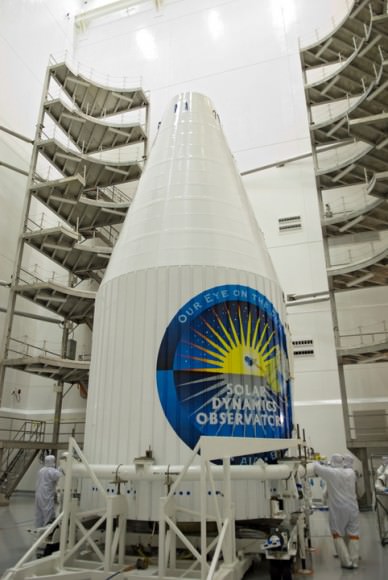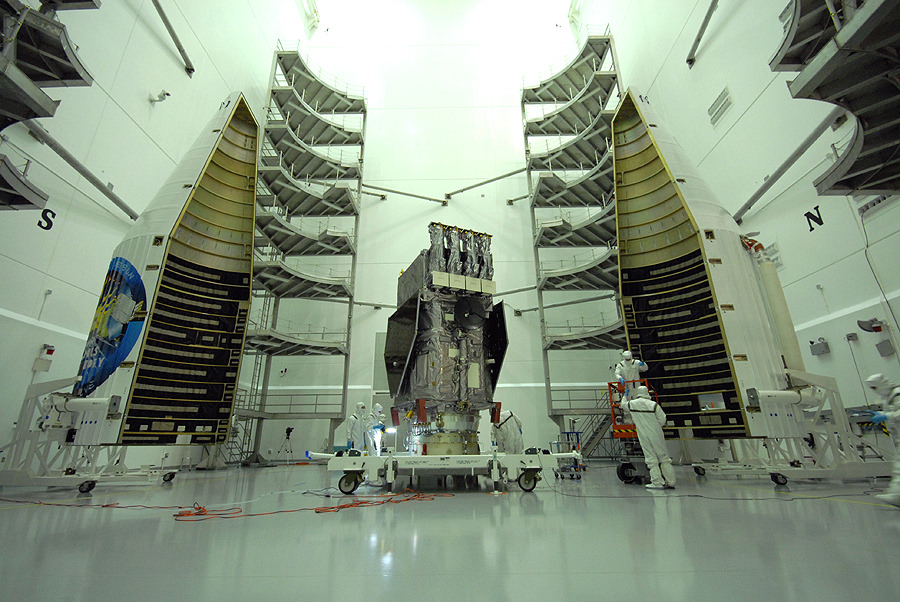[/caption]
NASA’s new solar science satellite, dubbed the Solar Dynamics Observatory, or SDO, moved an important step closer to launch when it was encapsulated inside its two piece payload fairing on Thursday (Jan 21) at the Astrotech Space Operations Facility nearby to the Kennedy Space Center (KSC). SDO is the most sophisticated spacecraft ever designed and constructed to study the sun and its dynamic behavior.
Liftoff of SDO aboard an Atlas V rocket from Cape Canaveral Air Force Station is targeted for Feb 9, just 2 days after the shuttle Endeavour blasts off with the Tranquility module and heads for the ISS.
“SDO will revolutionize our view of the sun. It will reveal how solar activity affects our planet and help us anticipate what lies ahead”, said Madhulika Guhathakurta at a Jan 21 press briefing. She is the SDO program scientist at NASA Headquarters.
The enclosed observatory will be transported on a specially designed trailer to Launch Complex 41 on Tuesday (Jan. 26) and then be hoisted up and bolted atop the two stage booster rocket. The 19 story tall Atlas V will propel the 8,800 pound spacecraft into an inclined geosynchronous orbit where it will study the sun in multiple wavelengths during its 5 year primary mission. It carries sufficient fuel to operate for another 5 years.

SDO is the first spacecraft to be launched as part of NASA’s Living with a Star (LWS) science program initiative. The goal is to better understand the causes of solar variability and to create better forecasts for predicting “space weather” which directly affects the Earth and all life inhabiting it. Furthermore, this information will be used to help protect and provide early warning to valuable satellites operating in space as well as astronaut crews working aboard the International Space Station.
When active regions on the sun erupt suddenly and violently in the form of a solar flare or coronal mass ejection (CME), they hurl millions of tons of solar material and charged particles toward Earth which can damage orbiting satellites, disrupt navigation systems and cause failures in the power grid.
SDO is equipped with 3 science instruments which will measure and characterize in-depth the Suns interior and atmosphere, magnetic field, hot plasma of the solar corona and the density of the radiation that creates the ionosphere of the planets.
SDO will collect huge volumes of data which amount to a staggering 1.5 terabytes per day. This is the equivalent of downloading a half million songs each day or filling a CD every 36 seconds. “That’s almost 50 times more science data than any other mission in NASA history”, says Dean Pesnell, the SDO project scientist at NASA Goddard.

“We’ll be getting IMAX-quality images every 10 seconds,” says Pesnell. “We’ll see every nuance of solar activity.” Because no orbiting spacecraft has ever come even close to this incredible speed, there is a vast potential for ground breaking science discoveries. Scientists hope to learn how storms are generated inside the sun and how they then evolve and propagate outwards through the suns atmosphere and towards earth and the rest of the solar system.
Since SDO has no on-board recording system, the data will be transmitted continuously on a 24/7 basis to dedicated receiving stations on the ground in New Mexico as it maintains position over 22,000 miles high above earths equator.
I will be reporting on site from the Kennedy Space Center in February and directly from the launch pads for both SDO and STS 130. See my earlier STS 130 reports here.


There will always be a special place in my heart for SOHO! BUT I for one, can’t wait to see SDO data start pouring in! Cool beans!
Offtopic:
I just saw a yellow star. Is it Mars???
What does “geosynchronous orbit” means in this case? Geosynchronous around the earth or the sun ? (I would expect around the sun, but is this possible?
Geosynchronous around the Earth. The SDO will take so much data that onboard storage of the data simply wouldn’t be practical fr any more than a few days worth of data. The spacecraft will be in geosynchronous orbit, and so will sit over the one part of Earth, which will have an antenna installed allowing down-linking of the data in real-time. Mmmmm – real-time data downlinking of super high-def Sun images. Happy days.
A syncronous orbit of the same type would be impossible around the Sun, or at least it would only be possible to match the rotation speed of a single latitude, given that the Sun exhibits differential rotation…